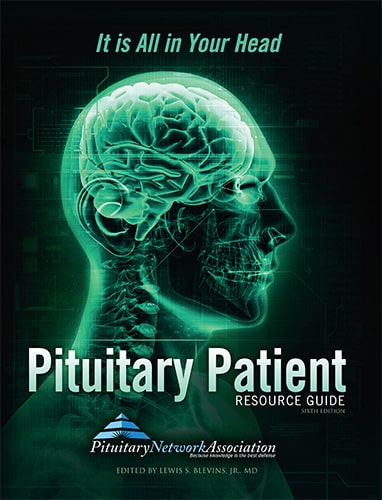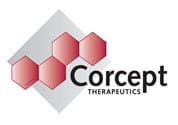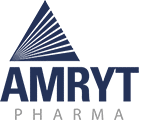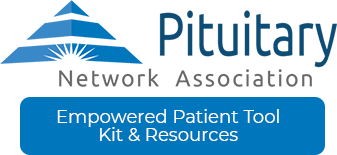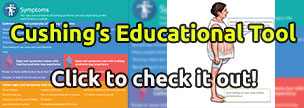Pituitary Glossary starting with A
Anterior Pituitary
The front portion of the pituitary.
Produces a number of hormones that affect other tissues and glands including ACTH, GH, LH, FSH, Prolactin, TSH.
Antibodies
Part of the immune system, antibodies are proteins produced by white blood cells that circulate in the blood looking for and attaching to foreign proteins and toxins to neutralize them.
Antibodies are a type of protein made by plasma cells (a type of white blood cell) in response to an antigen, or foreign substance. A single antibody can bind to only one specific antigen to help destroy the antigen. Antibodies can work in several ways, depending on the nature of the antigen. Some antibodies destroy antigens directly; others help white blood cells destroy the antigen.
Anticoagulant
Used to prevent the formation of blood clots.
A drug that helps prevent blood clots from forming; externally administered agents that prevent blood clotting. Also called blood thinner.
Anticoagulant Therapy
Anticoagulant drugs administered in a theraputic manner.
The use of anticoagulant drugs to reduce or prevent intravascular or intracardiac clotting.
Antigen
Antigens are capable of causing the production of antibodies and may or may not have an allergic reaction.
An Antigen is a substance that causes the immune system to make a specific immune response. An antigen may be a foreign substance from the environment such as chemicals, bacteria, viruses, or pollen. An antigen may also be formed within the body, as with bacterial toxins or tissue cells.
AO
Adult onset: occurring in adulthood.
Adult onset as in patients with growth hormone deficiency occurring in adulthood. Also referring to adult onset diseases such as type 2 diabetes.
Apnea
The absence of breathing.
Sleep apnea is a common sleep disorder characterized by brief interruptions of breathing during sleep. Episodes usually last 10 seconds or more and occur repeatedly throughout the night. People with sleep apnea will partially awaken as they struggle to breathe, but in the morning they will not be aware of the disturbances in their sleep. The most common type of sleep apnea is obstructive sleep apnea (OSA), caused by relaxation of soft tissue in the back of the throat that blocks the passage of air. Central sleep apnea (CSA) is caused by irregularities in the brain’s normal signals to breathe. Most people with sleep apnea will have a combination of both types. The hallmark symptom of the disorder is excessive daytime sleepiness. Additional symptoms of sleep apnea include restless sleep, loud snoring (with periods of silence followed by gasps), falling asleep during the day, morning headaches, trouble concentrating, irritability, forgetfulness, mood or behavior changes, anxiety, and depression. Not everyone who has these symptoms will have sleep apnea, but it is recommended that people who are experiencing even a few of these symptoms visit their doctor for evaluation. Sleep apnea is more likely to occur in men than women, and in people who are overweight or obese.
Arrhythmias
Abnormal heart rhythms; dysrhythmias.
An arrhythmia is a problem with the speed or rhythm of the heartbeat. During an arrhythmia, the heart can beat too fast, too slow, or with an irregular rhythm. A heartbeat that is too fast is called tachycardia. A heartbeat that is too slow is called bradycardia.
Arteriosclerosis
Hardening of the arteries; types generally recognized are: atherosclerosis, Mönckeberg’s arteriosclerosis, and arteriolosclerosis.
Atherosclerosis is a disease in which plaque builds up on the insides of the arteries. Arteries are blood vessels that carry oxygen-rich blood to the heart and other parts of the body.
Plaque is made up of fat, cholesterol, calcium, and other substances found in the blood. Over time, plaque hardens and narrows the arteries. The flow of oxygen-rich blood to organs and other parts of the body is reduced. This can lead to serious problems, including heart attack, stroke, or even death.
Cerebral arteriosclerosis is the result of thickening and hardening of the walls of the arteries in the brain. Symptoms of cerebral arteriosclerosis include headache, facial pain, and impaired vision.
Artery
A vessel that carries blood from the heart to the to other areas of the body.
Arteries that carry blood to the brain are the carotid arteries—one on each side of the neck—that divide into internal and external carotid arteries. The internal carotid arteries supply oxygen-rich blood to the brain. The external carotid arteries supply oxygen-rich blood to the face, scalp, and neck. Carotid artery disease is a condition in which a fatty material called plaque (plak) builds up inside the carotid arteries.
Arthritis
Inflammation of a joint or a state characterized by inflammation of joints.
Arthritis is caused by inflammation, of the tissue lining the joints. Some signs of inflammation include redness, heat, pain, and swelling. In some types of arthritis, the joints involved can become severely damaged. There are different types of arthritis. In some diseases in which arthritis occurs, other organs, such as the eyes, the chest, or the skin, can also be affected.
Articulation
The adjustments and movements of speech organs involved in pronouncing a particular sound, taken as a whole.
A neurological examination assesses motor and sensory skills, the functioning of one or more cranial nerves, articulation, hearing, vision, coordination and balance, mental status, and changes in mood or behavior, among other abilities.
Artifact
Something artificial, a distortion that does not reflect normal anatomy or pathology, not usually found in the body.
A structure or substance not normally present but produced by an external agent or action, such as a structure seen in a microscopic specimen after fixation that is not present in the living tissue. For example, in radiology, the appearance on an x-ray of a surgical metal clip that obscures the clear view of an anatomical structure.
Aspiration
An accidental sucking in of food particles or fluids into the lungs. Can also mean removal of a sample of fluid and cells through a needle.
Aspiration as a medical procedure is the removal of fluid or tissue through a needle, called a needle biopsy.
Breathing in a foreign object (such as sucking food into the airway).
The term can also refer to a medical procedure that removes substances from an area of the body such as air, body fluids, or bone fragments.
Asymptomatic
To have a disease condition without showing obvious outward symptoms.
Many pituitary patients however, do have mild symptoms that are simply not recognized by treating physicians.

